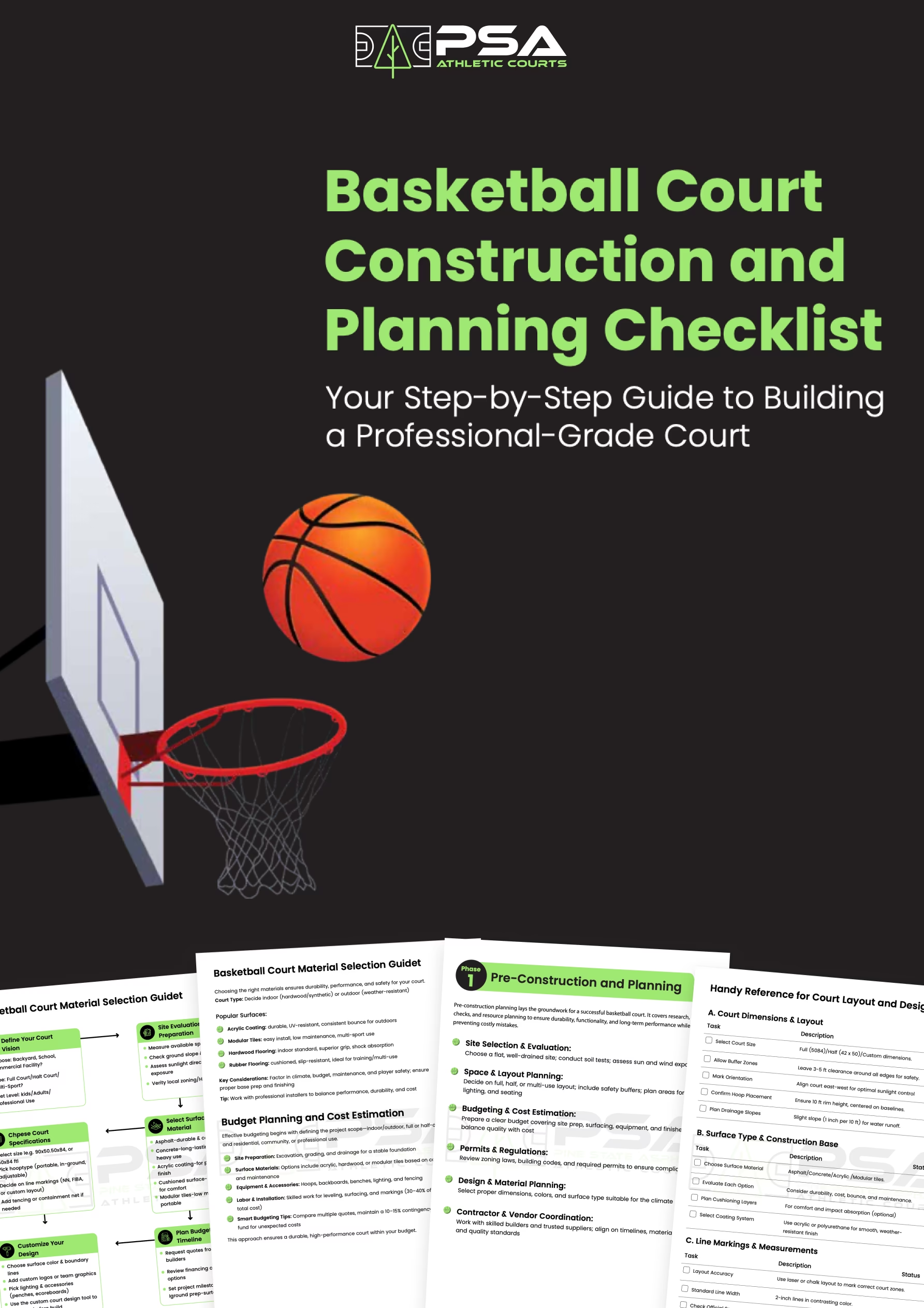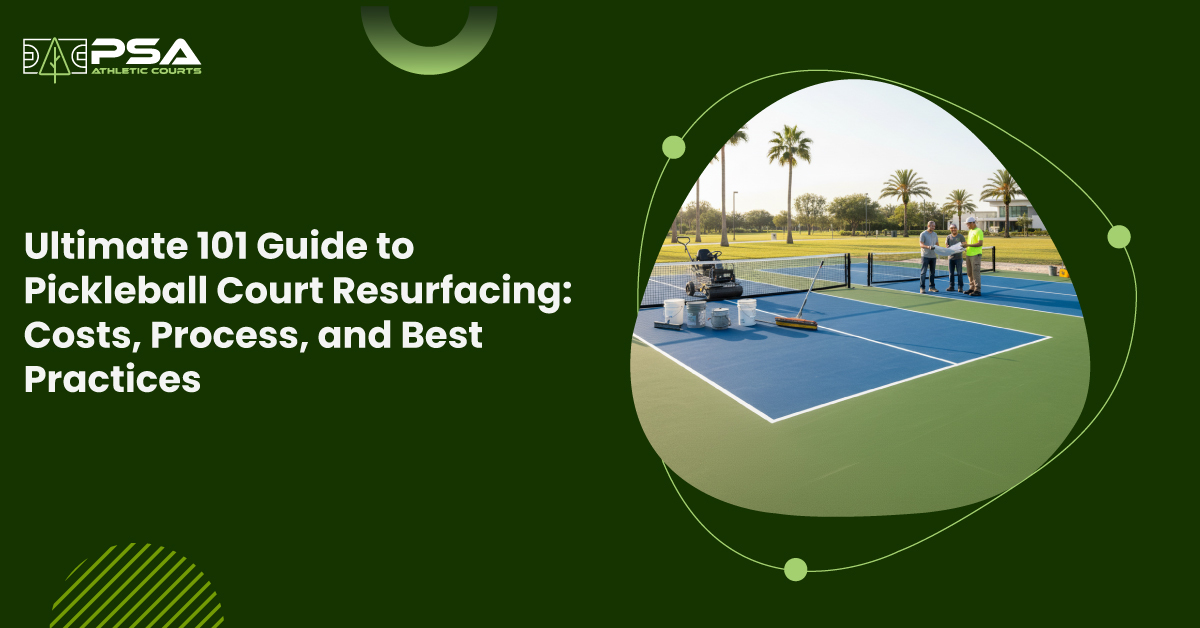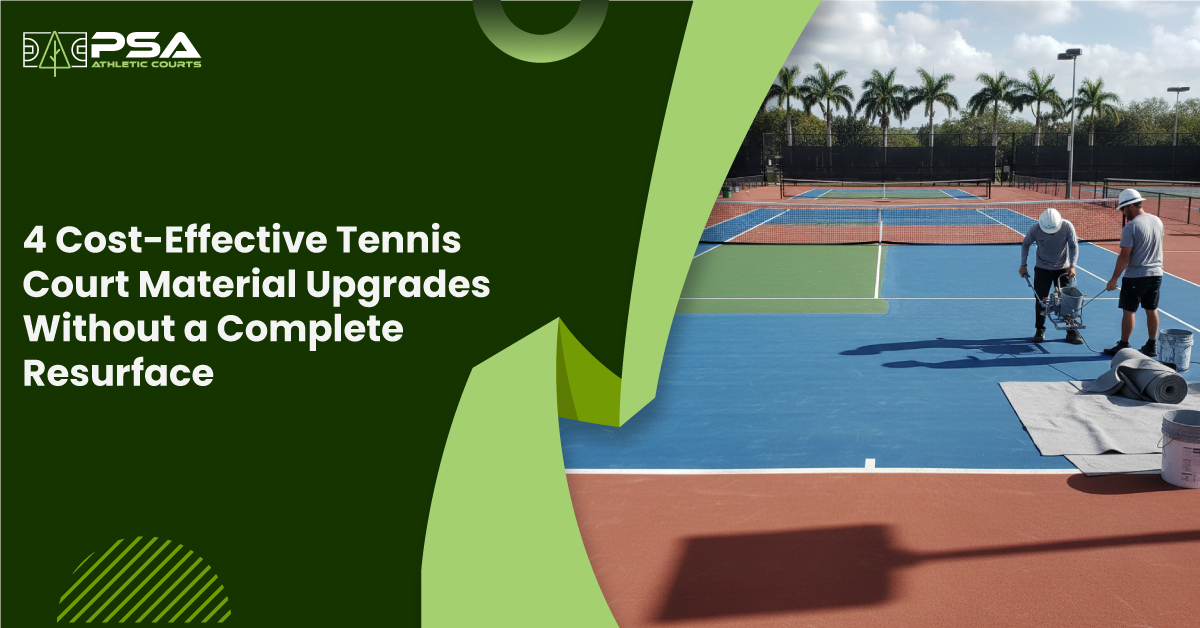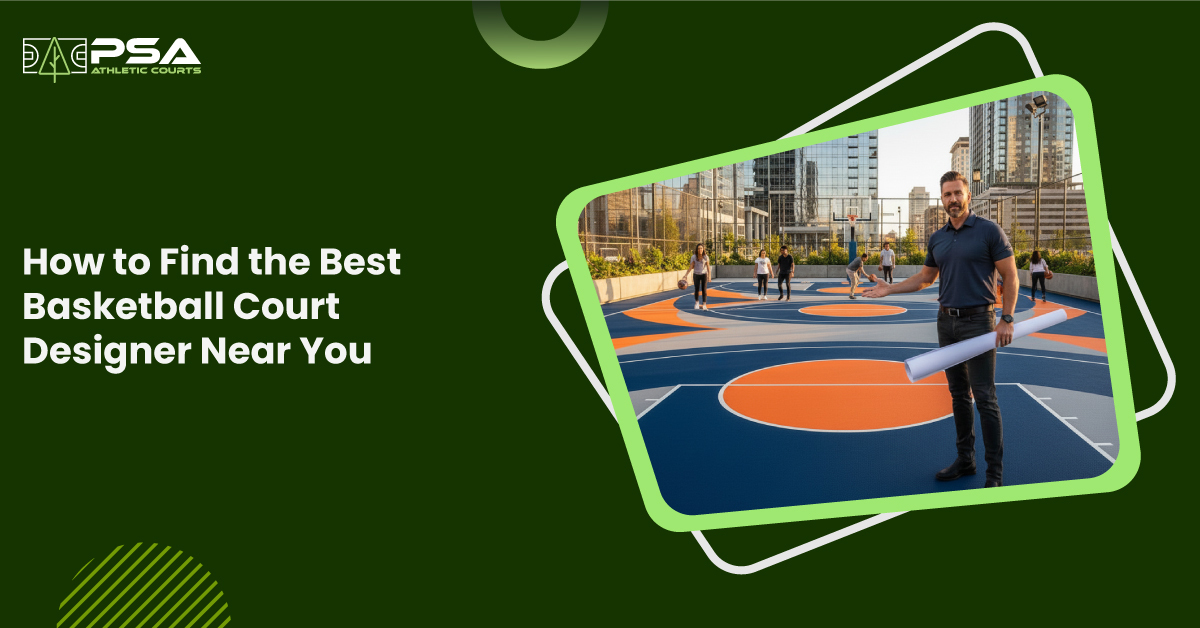Pickleball is a game like no other, it is a unique combination of the features of three sports: tennis, ping-pong, and badminton. The popularity of this game is on a rise for its simple rules and fast paced rallies that lead to competitive gameplay.
If you are new to this game, or are wondering if your pickleball court needs resurfacing then this guide by Pine State Courts will surely be of help. In this blog, we’ll cover everything related to the upkeep of the court, the signs of damage, resurfacing cost, and best practices to keep the court in best shape for a long time. So, let’s begin!
What is Pickleball Court Resurfacing?
Pickleball court resurfacing is a maintenance procedure that involves repairing the court for any damages that may have occurred over the course of time. These repair works are followed by a resurfacer and colored coatings which improves the appearance of the court.
Resurfacing thus adds to the charm and playability of the court. Here’s a few pointers to help you understand how resurfacing the pickleball court helps the court:
- Improves the aesthetics of the courts by repairing damages and touching up faded lines.
- Enhances player safety and performance with the improved traction and even playing field.
- Adds to the durability of the court by preventing the cracks or other damages from expanding further.
- Addresses any drainage or water pooling issues to prevent slipping on the court.
- A well maintained court ultimately adds to the property value by inviting more games and potential buyers.
Want to learn the basics of Pickleball? Here's Pine State Court’s guide on the 5 must-know facts about outdoor pickleball court dimensions & layout for an introduction to the game.
The Right Time for Pickleball Court Resurfacing
Although the International Pickleball Federation lays no specific guidelines to court resurfacing, a consensus is that resurfacing should be performed every 5 to 7 years. The actual time may vary depending on how well the court is maintained over the years.
The right time for pickleball court resurfacing is thus dependent on the following signs of damage:
- Uneven surface with cracks and bumps on the court.
- Waterpooling due to improper drainage and formation of birdbaths after a shower of rain.
- Faded court lines that confuse the players and reduce the appeal of the court.
- Poor ball bounce and reduced traction which compromises the player's safety and performance.
Pickleball Court Resurfacing Costs
Before diving into the process let’s first uncover the cost of resurfacing a pickleball court. Although it is not set in stone, it depends on a lot of factors including the extent of repairs needed, the corresponding labor cost, and whether you need any customizations. This cost can range anywhere from $3,500 to $15,000.
Here’s a list of the factors that influence the resurfacing costs:
- Size of the court: A full pickleball court will generally cost less than a multi-athletic court.
- Type of surfacing material : The type of surfacing material of the court, asphalt or concrete, and the acrylic coating on top also influence the cost.
- Extent of repairs needed: Any foundational repairs or removing the entire acrylic coating for resurfacing adds to its cost.
- Labor cost : While you can save money on the labor cost with DIY resurfacing, getting it done professionally ensures longevity.
- Additional customizations : Adding customizations to the court including cushioning and custom colors or logos also add to the resurfacing cost of the pickleball court.
The Pickleball Court Resurfacing Process
Wondering how long the resurfacing will take and what are the steps involved? Well! The process of resurfacing a pickleball court may take a few weeks to complete and as such you should choose a time when there aren’t any major matches or practice sessions scheduled.

Here’s an expert step-by-step guide for pickleball court resurfacing by pickleball court designers:
- Assess the court surface to check how damaged the court is.
- Prepare the surface, by cleaning it thoroughly using a specialized sports court pressure washer or gentle power rinsing. Avoid standard pressure washers, as they can damage acrylic coatings.
- Repair the cracks and uneven areas by using the same material as the surface of the court (asphalt or concrete). Address any drainage issues at this stage itself.
- Apply the acrylic resurfacer to improve the smoothness of the court.
- Leave the court surface undisturbed for drying and curing.
- Apply the color coating for the faded lines and worn out areas.
- Finally, inspect the court for the quality of repair work.
Best Practices for Pickleball Court Resurfacing
Now that you know all about resurfacing, there are still a few things that you should keep in mind before starting this project. We have compiled a list of some common pitfalls that you should avoid and a few best practices that will help you with this project.
The expert tips for pickleball court resurfacing include:
- Address any drainage issues before beginning the resurfacing project to enhance the longevity of your court.
- Do the resurfacing when it's 50 degrees and up outside as both asphalt and concrete mixes Cool temperatures can slow down curing and lead to improper bonding of the coating. This leads to inadequate compaction, resulting in a porous surface which is prone to cracking.
- Allow the coatings appropriate time to cure by leaving them undisturbed.
- Follow the manufacturer’s instructions and don’t over dilute the material to cover a larger area.
These practices ensure that your pickleball court construction goes smoothly and the resurfacing lasts for a long time. Proper maintenance and upkeep of the court is also crucial to increase the duration between subsequent resurfacings.
DIY vs. Professional Resurfacing
The resurfacing project is not an easy one and although many try to DIY it to save up on the labor cost, it is important to have the appropriate knowledge before beginning this project.
It requires extensive knowledge of the resurfacing materials, the curing times, and how to fix any drainage issues. Moreover, an improper resurfacing can lead to reduced lifespan of the court and may even deteriorate its condition.
This is why it is important to seek help from experts. With professional resurfacing, your court will receive the appropriate care and treatment it requires. It will also extend the life of the court, resulting in a superior finish and a game-ready court in no time.
Takeaway
Resurfacing the court isn’t some cosmetic makeover but addresses everything that’s wrong with the court. Pickleball court resurfacing thus ensures you get a professional-grade court that performs as well as it looks.
At Pine State Courts, we have an expert team that not only performs professional pickleball court construction but also undertakes its resurfacing and maintenance to ensure that your court is always ready to be played on. Contact us for any assistance.
Frequently Asked Questions
1. How often should a pickleball court be resurfaced?
A pickleball court should generally be resurfaced every 5 years but depending on the footfall and the weather conditions, a court may require more frequent resurfacing. With proper maintenance and timely repairs you can also extend the period between subsequent resurfacing procedures.
2. Can I resurface my court myself, or should I hire professionals?
You can resurface your court yourself but it requires extensive knowledge of the surfacing material and equipment. There’s also an inherent chance of messing up the project which is why it is best to seek professional help to repair the court and extend its life.
3. How long before I can use my court after resurfacing?
You can use your court a day or two after resurfacing it, this allows the court enough time to cure. Acrylic surfaces on asphalt take 24 - 48 hours for curing while on concrete take the longest, around 48–72 hours.
4. What is the best coating for a pickleball court?
Acrylic coatings are the most popular and best coatings for a professional-grade pickleball court. They improve the court performance by enhancing its traction and ball bounce. It also adds to the durability and player safety on the court.
5. Is concrete or asphalt better for a pickleball court?
Concrete courts are durable and low-maintenance, but more prone to structural cracking than asphalt. However, the surface stays smooth longer if maintained. They however cost more than asphalt which is more affordable and faster to install with better shock absorption. It however requires more frequent resurfacing, especially in cold climates.
The final decision should be made by considering the climatic conditions and whether the court is for long-term use or requires a quicker, budget-friendly installation.
DOWNLOAD OuR
FREE GUIDE
Ready to build your dream court?
Download our FREE Basketball Court Construction & Planning Checklist and get the step-by-step roadmap to building a professional-grade court—from budget planning to final touches.
No guesswork, just results.
